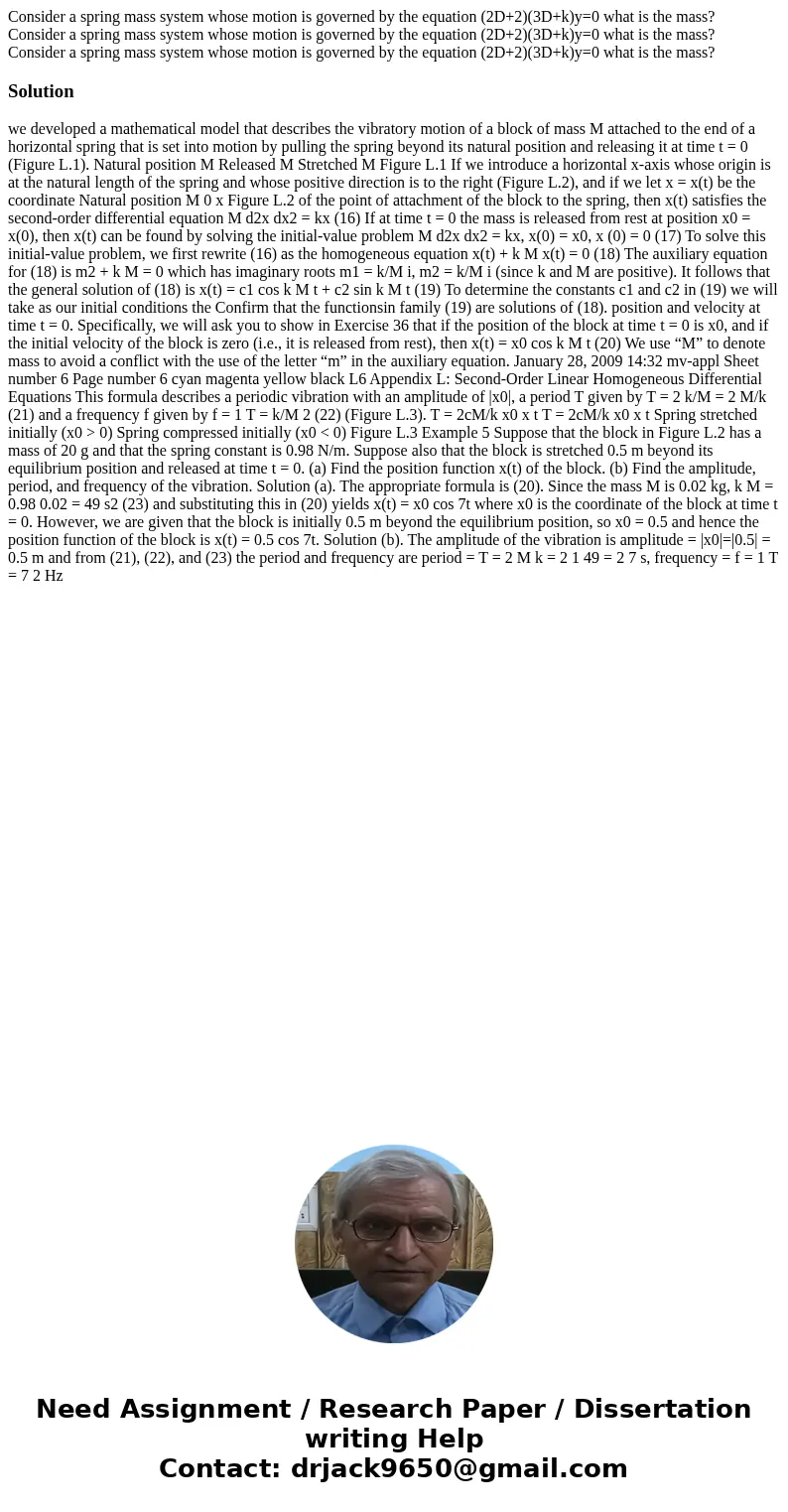Consider a spring mass system whose motion is governed by th
Solution
we developed a mathematical model that describes the vibratory motion of a block of mass M attached to the end of a horizontal spring that is set into motion by pulling the spring beyond its natural position and releasing it at time t = 0 (Figure L.1). Natural position M Released M Stretched M Figure L.1 If we introduce a horizontal x-axis whose origin is at the natural length of the spring and whose positive direction is to the right (Figure L.2), and if we let x = x(t) be the coordinate Natural position M 0 x Figure L.2 of the point of attachment of the block to the spring, then x(t) satisfies the second-order differential equation M d2x dx2 = kx (16) If at time t = 0 the mass is released from rest at position x0 = x(0), then x(t) can be found by solving the initial-value problem M d2x dx2 = kx, x(0) = x0, x (0) = 0 (17) To solve this initial-value problem, we first rewrite (16) as the homogeneous equation x(t) + k M x(t) = 0 (18) The auxiliary equation for (18) is m2 + k M = 0 which has imaginary roots m1 = k/M i, m2 = k/M i (since k and M are positive). It follows that the general solution of (18) is x(t) = c1 cos k M t + c2 sin k M t (19) To determine the constants c1 and c2 in (19) we will take as our initial conditions the Confirm that the functionsin family (19) are solutions of (18). position and velocity at time t = 0. Specifically, we will ask you to show in Exercise 36 that if the position of the block at time t = 0 is x0, and if the initial velocity of the block is zero (i.e., it is released from rest), then x(t) = x0 cos k M t (20) We use “M” to denote mass to avoid a conflict with the use of the letter “m” in the auxiliary equation. January 28, 2009 14:32 mv-appl Sheet number 6 Page number 6 cyan magenta yellow black L6 Appendix L: Second-Order Linear Homogeneous Differential Equations This formula describes a periodic vibration with an amplitude of |x0|, a period T given by T = 2 k/M = 2 M/k (21) and a frequency f given by f = 1 T = k/M 2 (22) (Figure L.3). T = 2cM/k x0 x t T = 2cM/k x0 x t Spring stretched initially (x0 > 0) Spring compressed initially (x0 < 0) Figure L.3 Example 5 Suppose that the block in Figure L.2 has a mass of 20 g and that the spring constant is 0.98 N/m. Suppose also that the block is stretched 0.5 m beyond its equilibrium position and released at time t = 0. (a) Find the position function x(t) of the block. (b) Find the amplitude, period, and frequency of the vibration. Solution (a). The appropriate formula is (20). Since the mass M is 0.02 kg, k M = 0.98 0.02 = 49 s2 (23) and substituting this in (20) yields x(t) = x0 cos 7t where x0 is the coordinate of the block at time t = 0. However, we are given that the block is initially 0.5 m beyond the equilibrium position, so x0 = 0.5 and hence the position function of the block is x(t) = 0.5 cos 7t. Solution (b). The amplitude of the vibration is amplitude = |x0|=|0.5| = 0.5 m and from (21), (22), and (23) the period and frequency are period = T = 2 M k = 2 1 49 = 2 7 s, frequency = f = 1 T = 7 2 Hz

 Homework Sourse
Homework Sourse